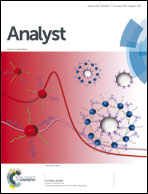Graphene oxide amplified fluorescence anisotropy for label-free detection of potassium ion†
Abstract
Fluorescence anisotropy (FA) has attracted considerable attention, but it has been rarely applied for the detection of small molecules and metal ions because they are too small to induce evident FA changes. Although some mass amplifying strategies have been developed, the recognition probes need to be covalently modified with the fluorescent dyes, which is complex and expensive. To overcome this limitation, a new simple, label-free and cost-effective method for the sensitive detection of potassium ion (K+), by using graphene oxide (GO) as FA enhancer, a G-rich single stranded DNA (ssDNA) as recognition probe and acridine orange (AO) as FA reporting fluorophore, was established in this paper. In the absence of K+, both ssDNA and AO are adsorbed on the surface of GO, and the FA of AO is enhanced greatly because the rotation of AO is coupled with the entire formation. After the addition of K+, the ssDNA self-associates into the G-quadruplex structure. Then, AO can bind with the formed G-quadruplex strongly, keeping away from the surface of GO, and the FA of AO decreases significantly because of the relatively small size of the complex of AO and G-quadruplex. Thus K+ can be detected sensitively in the range of 10 μM–2 mM based on the evidently decreased FA. This method is a further improvement of the previous reported mass amplifying strategies because it does not require any covalent labelling of the recognition probe, and it can be potentially applied for detection of a variety of other targets.


 Please wait while we load your content...
Please wait while we load your content...